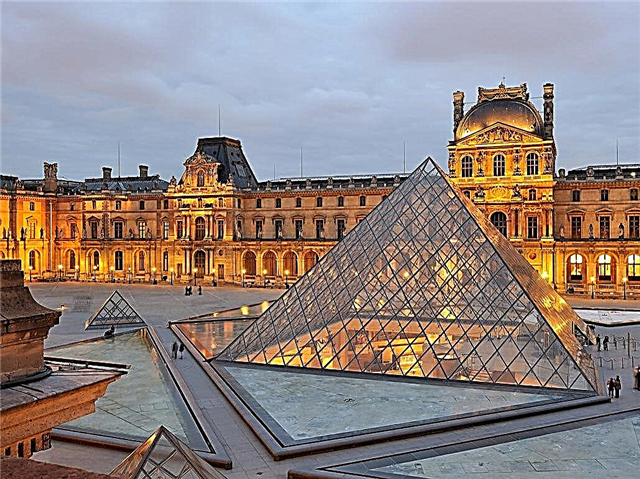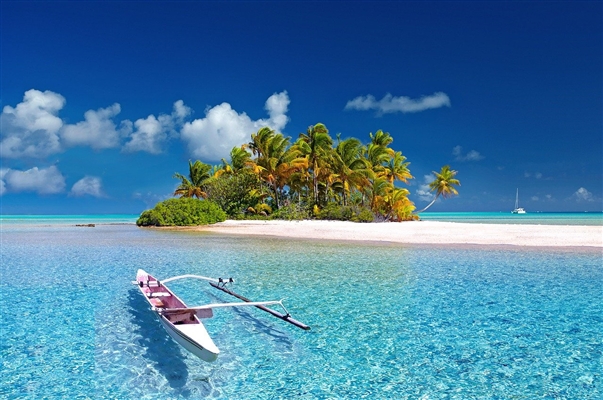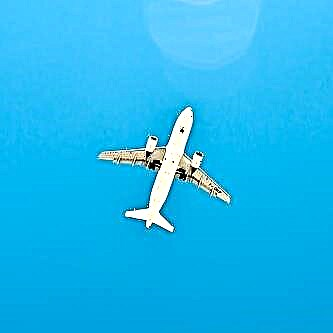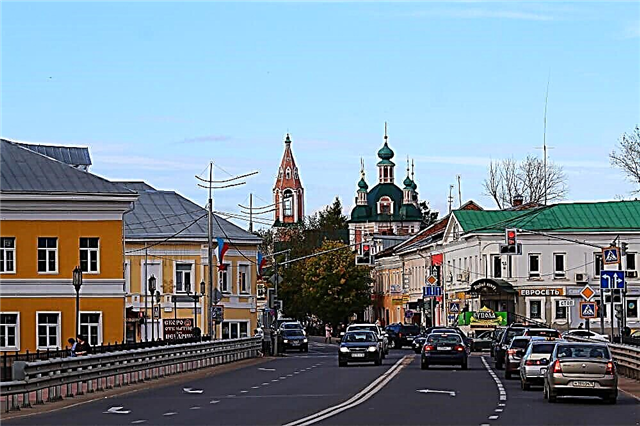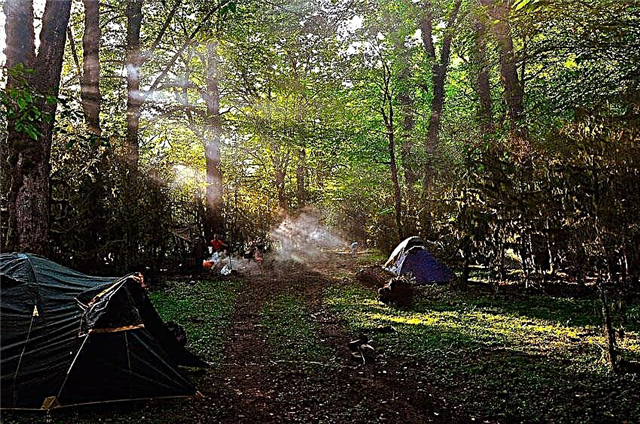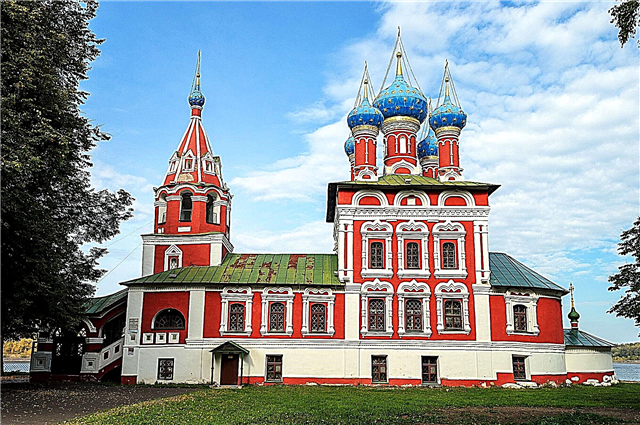The main attraction of Uglich is located in its historical center - the Kremlin, the architectural ensemble of which was erected on the site of an ancient fortress in the 19th century. It includes elegant and majestic temples, administrative buildings. They house the departments of the Art and Architectural History Museum, which has collected a unique collection of ancient exhibits and objects of art.
The centers of attraction for both pilgrims and tourists are monasteries with a long history. Alekseevskaya, Voskresenskaya and Epiphany monasteries in many ways shape the appearance of ancient Uglich. Of modern buildings, the most interesting is the Uglich Hydroelectric Power Station, the architectural ensemble of which is a cultural monument. All of its buildings are designed in the same style, demonstrating that industrial buildings can be beautiful.
The most interesting and beautiful places
List, photos with names and descriptions of the best sights of Uglich. He will help you plan routes and choose excursions to explore the top places of the city and its environs in 2-3 days.
Uglich Kremlin
The historical architectural complex is located on the banks of the Volga. The last time the fortification was erected in the 17th century. But after 100 years, the military fortification became unnecessary and it was dismantled. Currently, the Kremlin ensemble in Uglich consists of the reconstructed Chambers of the Uglich princes, as well as the Church of Dimitri, the Transfiguration Cathedral and the high bell tower next to it.

Church of Demetrius on the Blood
It was erected at the end of the 17th century on the alleged place of the murder of the Uglich Tsarevich Dmitry. In 2017, the prestigious British newspaper The Telegraph included it in the list of the most beautiful churches in the world. It has an elongated ship-like shape. Its facade is elegantly decorated in the old architectural style. The walls of the church are painted red to symbolize spilled blood. The details of the decoration are highlighted in white - platbands, kokoshniks, half-columns.

Transfiguration Cathedral
Built in 1713. In 1730, a high bell tower was added to it. A striking example of the art of Yaroslavl architects. The temple looks graceful and slender thanks to the high central dome and beautiful domes on the sides. Its magnificent architecture attracts many tourists. The interior walls and vaults of the cathedral are decorated with frescoes that depict scenes from the New Testament, there is a copy of Raphael's fresco in the Vatican.

Volga river embankment
It was laid in the central part of the city from Victory Park to the very outskirts. Motor ships with tourists wishing to explore the ancient city arrive at the quay of the embankment. Therefore, the embankment in Uglich looks beautiful and respectable. There are several old churches opposite the embankment. The pedestrian area of the embankment is equipped with observation platforms with picturesque views.

Uglich Art Museum
The expositions of the museum are located in the historical premises of the Epiphany Cathedral, the Chambers of the Uglich princes. The museum also includes the Church of Demetrius on the Blood. The building of the former City Duma houses an exposition of Orthodox paintings by contemporary artists. The rest of the buildings display a collection of merchant portraits of the 19th century, works by the artist from Uglich P. Buchkin, a collection of manuscript books.

Chambers of the Uglich princes
Built by the Uglich prince Andrei Vasilievich in the 1480s. During the construction, the building was harmoniously entered into the landscape of the Volga bank. In the 16th century, Tsarevich Dmitry and other Uglich governors and princes lived in the Chambers. In the 18th century, the princely Chambers fell into disrepair, but in the 19th century they were reconstructed in the same glamor of the "Russian style". Now its walls are occupied by expositions of the State Museum with exhibits of the 17th-19th centuries.

Uspenskaya square
The historical square of the city, which from the 15th-16th centuries was called Torgovaya. Before a strong fire at the beginning of the 20th century, trading shops were located here, and of the four churches of the square, only one survived - Kazansky. In addition to the temple, the ensemble of the square includes the Alexander Nevsky chapel, the Evreinovs' house, and the building of the public library. The main city events and holidays are held on the square.

Victory Park
Located in the city center next to the Kremlin. Asphalt alleys are laid among the trees. In the center of the park there is a monument dedicated to the residents of the city who died in the battles of the Great Patriotic War. In addition to pleasant walks along the quiet alleys, active recreation is also possible - there are boats and catamarans for rent at the boat station, and musical evenings are held. There is a playground for children.

The architectural complex of the Uglich hydroelectric power station
The objects of the Uglich hydroelectric power station often appear in photographs of tourists from Uglich. You can visit the museum, see the beautiful gateway arch and enjoy the views of the reservoir.
Uglich hydroelectric power station
The second stage of the cascade of the Volzhsko-Kama hydroelectric power station. It consists of an earthen dam with a length of 314 meters, a spillway dam with a length of 179 meters, the building of the hydroelectric power station itself with two units, as well as a shipping channel. All buildings are decorated in the same Soviet style and harmoniously fit into the look of the old Volga river bed. The construction of the first stage of the hydroelectric power station began in 1938 and was completed in 1940. The hydroelectric power station started operating at full capacity in 1955.

Museum of the History of Hydropower of Russia
Opened in 2017. It is located within the walls of the former Volgolag administration. The expositions, located in 11 halls of the museum, tell about the history of hydropower. The uniqueness of the museum exhibits has been confirmed by the world's leading hydropower engineers. A few years after its opening, the museum received the Senkevich Prize as the best museum in the province. Visitors will be told about the creation of the Uglich hydroelectric power station, its technical component.

Shipping lock of the Uglich hydroelectric power station
Located on the left bank. The lock chamber is 290 meters long. The sluicing process is extremely interesting - the ship enters the chamber, after it is closed, water begins to flow into the lock. Thus, the vessels overcome the difference in height of 12 meters. The filling time of the sluice is 9 minutes. The entrance to the gateway is decorated with a beautiful arch. You can enjoy its impressive view while sailing on a motor ship through the lock.

Uglich reservoir
Formed during the flooding of the Volga valley during the construction of a hydroelectric power station in 1939. The length of the reservoir is 146 km, the maximum width is 5 km. Now it is also one of the favorite recreation areas for citizens and guests of the city. On its shores there are landscaped and wild beach areas, places for tents and comfortable recreation centers. The reservoir is home to about 30 species of fish. Most of the bases rent gear and boats.

Monuments and monuments of Uglich
There are not many monuments and monuments in Uglich, be they modern or historical. There are much more interesting museums here.
Obelisk of Glory
Installed in 1977 in memory of the defenders and workers of Uglich. Located in Victory Park on an artificially filled hill. The project of the monument was chosen for about two years. The monument is a high three-sided bayonet with bas-reliefs, surrounded by a bastion. The bas-reliefs depict the figures of a worker, a peasant woman and a soldier who, together, brought victory to the country. Memorial words and poems by V. Smirnov are engraved on the plates.

Monument to Tsarevich Dmitry
Opened in 2015. The sculptor Rukavishnikov worked on the monument, who was guided by the image created by the artist Nesterov in the 1899 painting "Tsarevich Dmitry Murdered". The height of the monument is 3 meters. It is installed near the walls of the Chambers of the Uglich Princes, where, according to the law, objects with a height of more than 1.5 meters cannot be placed. However, for the monument to Tsarevich Dmitry, an exception was made at the federal level.

Tractor HTZ-15/30
A 1936 tractor was installed on the territory of the Kremlin. This model was produced by the factories of Stalingrad and Kharkov and was the most widespread in the 1930-1940s. In total, almost 400,000 copies of such tractors were produced in the country. By installing the monument, the city administration immortalized the memory of Zina Zolotova, who became the first tractor driver in Uglich, and later the head of a brigade of tractor girls.

Interesting museums of Uglich
The most popular museums in Uglich, which are worth visiting.
Arsenal of unusual bicycles "Samokat"
A private museum that tells about the history of the development of two-wheeled vehicles. The exhibition features bicycles and scooters from different times - from the very first to the modern. The founder of the museum is Sergei Kondakov, a participant in cycling marathons. The uniqueness of the museum is in its interactivity - you can touch all the exhibits, take photos, get behind the wheel and even ride them. Master classes are held. The museum is located near the Kremlin.

Museum of Urban Life
It will be useful for tourists interested in the history of the city. It is located in the building of the public library and occupies only two rooms. However, the expositions of the museum are very original - the furnishings of the 19th century are recreated in the halls with exhibits. Both everyday objects of everyday life of people with average incomes and rare exhibits are presented. Theatrical performances and musical evenings are held, and a thematic menu is presented in the tea house.

Museum of Prison Art
It is located next to the bicycle museum at the Uglich Kremlin. It contains objects created by prisoners of different times - paintings on sheets, drawn maps, icons, crafts made of wood and bread, master keys, moonshine stills. Also on display are letters from prisoners. One of the rooms of the museum is designed in the form of a prison cell with bunks and a metal table, with mannequins in the form of prisoners. There is a souvenir shop at the museum.

Folk Toy Museum
Private collection of toys from different regions of Russia and more than 30 countries of the world - Vietnam, Burma, China, Japan, Laos. The toys are made from different materials - clay, wood, bronze, textiles, talc. There are special toys used to carry out folk rituals - wedding, religious, drive away the evil forces that contribute to fertility. The museum conducts master classes, thematic lectures, excursions, festivals.

Leathercraft Museum
Located in the city center in an old mansion. The expositions of the museum present to the attention of visitors both the products of the masters of the past centuries, and the works of the masters of our time. Among the products are clothes, shoes, books, utensils. The guides talk about the history and development of leatherworking in our country. Among the exhibits there are models of devices and machines for leather dressing, multimedia installations.

Gallery "Under the Blessed Cover"
It is located in an old building next to the Kamenny Brook near the Kremlin. The gallery displays works of contemporary Orthodox art, as well as works of decorative and applied art of a religious nature of the 15th-19th centuries. Separately, the works of Sergei Simakov - Abbot Raphael are distinguished. Themed excursions are conducted around the gallery, telling about the history of Orthodox Russia.

Museum of Myths and Superstitions of the Russian People
Private museum located at the Resurrection Cathedral. It represents the creative workshop of Daria Chuzhaya. The museum is dedicated to the study of epics, fairy tales and legends of the Slavs. Among the exhibits you can find many mythical creatures in which the Russian people believed - goblin, brownies, witches, kikimors, ghouls. A large number of amulets and talismans were collected, which protected people from evil spirits.

Museum "History of Russian Vodka"
Opened in 1999. Uglich was not chosen by chance to host such a museum. It was here that Peter Smirnov was born, who became the founder of the famous brand for the production of alcoholic beverages. The expositions of the museum tell in detail about the production that he founded and about his personality. Among the exhibits there is an exhibition of old bottles and utensils for drinking strong drinks, moonshine stills, alcoholic beverages.

Playing Cards Museum
A private museum located in the city center adjacent to the Prison Art Museum and the Toy Museum. Visitors are told about different types of cards - playing, divination, magic, about the history of their origin. Several hundred different decks are exhibited - for children, theatrical, made of bread, for the blind, giant and figured. They conduct master classes on fortune-telling and solitaire layout, teach card tricks.

Uglich History Museum
It is located in a beautiful carved wooden building on Bakharev Street. This is the oldest private museum in Uglich - it was opened in 1983. Initially, it was called "Uglich Ringing", and the main exhibits of the museum were bells. Over time, many items appeared in the museum's collection that tell about the history and culture of the city, starting from the 15th century. Among the visitors to the museum are guests from 21 countries of the world.

House-Museum of Vasily Kalashnikov
It is located in a unique building that has been preserved on Pervomayskaya Street since the 18th century. The front part is built of stone, the rest is made of wood. In this house, the designer Kalashnikov was born and lived until the age of 16. There are three main expositions in the house - a glass museum, a museum of Russian tea drinking culture and a reconstructed Kalashnikov office. Items of the 18th-19th centuries are exhibited - furniture, mirrors, dishes, samovars, there is a real Russian stove.

Architectural landmarks of Uglich
Civil and industrial architectural monuments are represented not only by the objects of the Uglich hydroelectric power station. Historical merchant houses have been preserved in the city, shopping arcades and the building of a fire tower are interesting.
The building of the former city council
The two-storey building of the City offices was erected in the years 1813-1815. It has a symmetrical facade, decorated with columns and a mezzanine. The interior is decorated quite austerely for the 19th century, which indicates the influence of the state style. Stucco cornices, a vaulted ceiling, and tiled stoves have been preserved from the decorations. The rooms where valuables were kept have beautiful wrought-iron doors.

Fire Tower
Also known under the name Furmanov House, which meant the location of the fire brigade within its walls. Located next to the building of the city council. The tower of Uglich was built in 1829-1831. The two-storey building with a mezzanine and a four-column portico was built with elements of provincial influences from local architects. In the center of the building stands a tall tower, from which firefighters monitored the safety of the city.

Shopping arcade
They are located in the old part of the city on Uspenskaya Square, formerly known as Torgovaya Square. Two buildings have survived from the large shopping complex. One of them, in the style of provincial classicism, at the end of the 19th century was the flour shop of the merchant Skornyakov. Next to it is the second surviving building of the Trading Rows. Now it houses a hotel. It was built in the 18th century; in the 19th century, arched openings were added to it.

Zimin dvor
The estate, which belonged to the Zimin merchants, was built in the 18th century. The Zimins lived in it until 1876, after which they sold it to the city. Under Soviet rule, it housed a school, and after an elementary school. Zimin Dvor is located on Soviet Square. The building has a U-shape and austere ascetic appearance without decorations. Only its central part has a mezzanine, which gives the historic building a classic look.

House of merchants Evreinov
The magnificent and majestic building is located on the Assumption Square. It is surprising that one of the most luxurious buildings in Uglich was built not by its richest merchants - the Evreinov brothers. Construction of the house began in 1892. The furnished rooms on the second floor were rented out as hotel rooms, while the first floor housed shops. The luxurious interiors of the concert hall on the second floor have survived to this day.

House of merchants Pereslavtsevs
A luxurious merchant's mansion in the traditional classicist style is located on Bergholz Street. Construction of the house began in 1804. It was built of wood and plastered on top. The masters were able to do this work so skillfully that many modern architects call the Pereslavtsevs' mansion a provincial masterpiece. In the 1990s, the original building burned down and a replica was built in its place.

House of the Vinogradovs
The House of the Vinogradov merchants was built in the 19th century. This is one of the architectural and cultural heritage of Uglich. The historical building is a decoration of Moskovskaya street. Its rich and elegant appearance immediately attracts the attention of tourists. The arched windows of the two-story luxury home are decorated with openwork stucco molding and carved decor. A balcony is attached at the cut-off corner of the house, and a small turret rises from above.

House of Pivovarovs
A beautiful carved house is located at the intersection of Yaroslavskaya and Svoboda streets. The Pivovarov family has been known in Uglich since the 18th century. The residential building was built by them in the 19th century and is still one of the most significant architectural structures in the city. In appearance, the house looks like a small Russian elegant tower. It is interestingly decorated with figured carvings and wooden pilasters. The house is two-storey, but its first floor looks more like a basement.

Churches and temples of Uglich
The city is adorned with beautiful churches and temples that can be viewed from the side or go inside. Some were built three or more centuries ago.
Chapel of Alexander Nevsky
Located on the Walk of Fame. It is part of the memorial complex in honor of the defenders of the Fatherland. Built in 2003. The octagonal base of the chapel is completed by a dome with an openwork cross, located on four columns. Has an unusual color scheme - faced with red and black granite. Mosaic icons are located in the arched niches of the walls. There are flowerbeds in the area around the chapel.

Church of the Nativity of John the Baptist
Built in 1690 with donations from the merchant Nikifor Chepolosov in memory of his killed 6-year-old son. Located near the Resurrection Monastery on Spasskaya Street. The uniqueness of the old church was appreciated even in Soviet times. On the site where the church is located, it was planned to build a hydroelectric power station, however, for the sake of preserving the historical architectural monument, the hydroelectric project was revised and the construction was moved upstream of the Volga.

Kazan Church
Located on the Assumption Square. The only surviving of the four churches that made up the religious ensemble of the square. Built in the 18th century in a baroque style. The slender appearance of the church is directed to heaven. Narrow and high arched windows give the building a swiftness. In Soviet times, the church bell tower was destroyed. It was restored in the 2000s, a 50-pound bell was cast for it in Tula.

Church of Tsarevich Demetrius "on the field"
Located on Rostovskaya Street, at the entrance to the city. It is believed that at this place a trickle of blood was shed from the relics of Tsarevich Dmitry during their transfer to Moscow. The graceful church was built at the turn of the 18th-19th centuries. The five-domed church has a classic look, its main façade is decorated with four Tuscan columns. Inside the church, there are frescoes painted in 1836, as well as a carved iconostasis.

Korsun Church
A beautiful white-stone church meets travelers at the entrance to Uglich from Yaroslavl. The elegant building immediately attracts attention with its elegant, openwork decoration in the style of wooden architecture. The church was erected in the 18th century on the site of the 13th century monastery destroyed by the Poles. During the construction, the surviving icon of the Korsun Mother of God was discovered, in whose honor the church was consecrated.

Florus and Lavra Church
Located at the ship's pier on the banks of the Volga, on Ostrovsky Street. Built at the expense of parishioners in 1762 instead of a wooden church in 1633. Until 1917 it was known as the Resurrection Church. The high stone church was built taking into account the traditions of the Uglich craftsmen. Small domes are located on graceful drums, windows are made in 3 rows and decorated with baroque-style platbands.

Church of Elijah the Prophet in the village of Zolotruchye
Built in 1753 at the initiative of the retired captain of the Life Guards Sukhovo-Kobylin in a village near Uglich. She had two thrones - in honor of Elijah the Prophet and Nicholas the Wonderworker. From 1924 to 2000, there were no services in the church. In 2004, both thrones were consecrated anew. In 2014, a bell tower was added to the church. The construction was carried out at the expense of the parishioners. The appearance of the old church is rather modest and austere.

Ancient monasteries of Uglich
The ancient monasteries of Uglich are impressive in scale and grandeur. The preserved and functioning monasteries attract pilgrims from all over the country.
Resurrection monastery
The exact date of the foundation of the monastery is unknown. According to one version, it was founded in the 13th century, according to another - in the 15th century. The buildings of the monastery that have survived to the present time were erected in the 17th century. The highest building of the monastery is the majestic Resurrection Cathedral. The small church of Hodegetria is located nearby. The building of the belfry connects the cathedral and the church. The monastery is located on Spasskaya Street, in a picturesque place on the banks of the Volga.

Epiphany monastery
Convent founded at the end of the 15th century. Located in the center of the city. In the 18th century, the wooden buildings of the monastery were rebuilt in stone. The active construction of new buildings in the monastery continued in the 19th century - then the appearance of the monastery took on almost completely Russian-Byzantine style. The most notable buildings of the monastery are Epiphany Cathedral, Feodorovskaya Church, Smolensk Church.

Alekseevsky monastery
According to chronicles, it was founded in 1371. One of the oldest surviving buildings of the monastery is the Assumption Church, built in 1628. The building, modest in appearance, is distinguished by three cone-shaped heads that create the image of a crown. In 1681, the Church of St. John the Baptist was erected with original tile decoration. Also in the 16th century, Rostov masters erected the Alekseevskaya church of the classical form.

Nikolo-Uleyminsky monastery
Convent located 11 km from Uglich in the village of Uleima. Belongs to the Old Believer Orthodox Church. Founded in 1406. On its territory, behind a low stone wall with towers, many buildings of the 17th and 18th centuries have been preserved. The first stone building of the monastery is St. Nicholas Cathedral in 1677. In 1695 the Vvedenskaya church was erected. A hotel has been built for the pilgrims.


